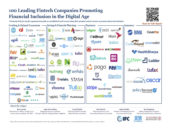
The Role Of Digital Finance In Financial Inclusion In Southeast Asia
by Fintech News Singapore June 22, 2017Asian Development Bank’s (ADB) recently concluded study on digital finance in the region found that addressing digital finance in the countries focused on could boost their gross domestic product (GDP) greatly.
The study, named “Accelerating Financial Inclusion in Sout-east Asia with Digital Finance” focuses on four Southeast Asian markets, namely Indonesia, the Philippines, Cambodia and Myanmar. ADB, together with consulting firms Oliver Wyman and MicroSave, also focused on financial inclusion in three segments: base of pyramid (BoP); women and micro, small and medium enterprises.
From its interviews with 80 stakeholders across the four markets and extensive resarch and analysis, it found that increasing the opportunity of digitla finance could boost Gdp by between 9 percent to 14 percent, even in relatively large economies such as Indonesia and the Philippines. The potential boost to GDP is as high as 32 percent in Cambodia, said the study.
“Making the most of this opportunity could also help influence the future shape of the financial services industry, particularly in smaller markets such as Cambodia and Myanmar, where only a small percentage of the current needs for financial services are met by formal providers,” the report noted.
“In Cambodia, for example, formal institutions meet only 16% of the demand for savings facilities from people in the financial inclusion target segment,” it further highlighted.
Digital finance’s impact on Southeast Asian society
The impact on better digital finance options are far-reaching for low income populations, women and small enterprises. Examples of uses of the new technologies include:
- Alternative platforms, such as mobile phones and digital platforms, to enable last-mile access. These will be able to reach the financially excluded and people in rural areas without the need for physical bank branches.
- Alternative digital information, such as biometrics data, to verify customer identity for account opening and payment authorisation.
- Analysis of transactional and digital footprint data to generate insights to improve customer targeting and credit risk assessment.
- Mobile wallets developed by non-banks, such as mobile network operators, to improve the customer experience in savings and payments.
Increasing financial inclusion will require action from regulators and public policymaking institutions. However, obstacles remain: resource and investment mobilisation continue eo be held up by the unattractive economics of serving the three segments, said the report.
On the supply side, resource and investment mobilisation continue to be held up by the unattractive economics of serving the three segments. For target customers, the solutions offered by the formal financial services sector often do not appear attractive enough as alternatives to existing informal solutions – partly because of their low level of financial literacy and overall awareness.
The study noted that digital financial solutions could play a significant part in closing gaps in financial inclusion. They could address about 40 percent of the volume of unmet demand for payments services and 20 percent of the unmet credit needs in the BoP and small business segments.
ADB estimates that the cumulative effect of digitally driven acceleration in financial inclusion could boost GDP by 2 percent to 3 percent in markets like Indonesia and the Philippines, and 6 percent in Cambodia.
“For the population earning less than $2 a day, that would translate to a 10 percent increase in income in Indonesia and the Philippines, and an increase of around 30 percent in Cambodia,” ADB pointed out.
What changes are needed? 
The report suggested that to close the gaps, a level-playing field of financial services must be created. One way is to allow collaboration and competition between traditional financial services players and new types of participants such as mobile network operators (MNOs).
There also needs to be a unified roadmap for financial inclusion in order to focus the efforts of various stakeholders, as well as a governance mechanism to facilitate coordination and ensure accountability for action in all relevant government departments. Data security must be strengthened, now that users will leave a trail in every transaction, said the report.
The BoP could be the biggest beneficiary of digital finance, the report concluded. It is a particularly vulnerable segment given its low financial literacy, its lack of alternative options (for accessing credit, for example), and the difficulty it has in voicing grievances effectively. Public policy will play a vital role in consumer education and protection through the enforcing of suitable policies and regulations.
Featured image via Pixabay








